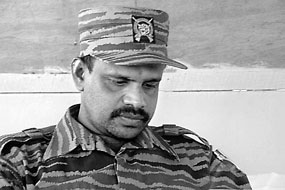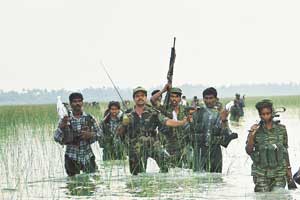
Death of Balraj and its implicationsThe media have branded the death of the LTTE’s senior commander, Balasegaram Kandiah alias Balraj, a blow to the LTTE, while Sri Lankan military and government officials applaud the death as a victory for Sri Lanka’s territorial integrity and sovereignty.
Brigadier Balraj was born on November 27, 1965, to a middle class family in Kokkuththoduvai in the district of Mullaitheevu in northern Sri Lanka, and joined the LTTE in 1983. Balraj led many missions, including the capture of the Wanni region and the Elephant Pass military base in 2000. One of the battles was in 1993 when the Sri Lankan army launched a major offensive against the LTTE in the north code named, Yarl Devi, under the command of present Lt. General and overall commander of the army, Col. Sarath Fonseka. Balraj served as the LTTE’s commander while Deputy Commander Theepan led the counter-offensive against the advancing Sri Lankan armed forces. The LTTE launched a surprise attack on government forces in Puloappalai, inflicting heavy casualties and destroying tanks and armoured vehicles and and staking claim to the area within six days. Both Col. Fonseka and Balraj were wounded, Balraj in his right leg. Despite ongoing difficulty with his right leg as a result of this injury, he continued to lead many battles. Balraj led the LTTE into conventional military force During the early 1990s, the LTTE leadership realized they needed a conventional regiment to fight Sri Lanka’s conventional armed forces and to show the world that the Tamils had the capability of defending themselves through conventional means, justifying their demand for an independent State of Tamil Eelam. Although an expert on psychological and guerrilla warfare, LTTE leader, Velupillai Pirapaharan, assigned Balraj as the first commander of the first conventional LTTE regiment formed on April 10, 1991 – the Charles Anthony Brigade, named after the LTTE’s senior leader and the leader’s close friend, Charles Anthony of Trincomalee who was killed on July 15, 1983, in Meesalai in northern Sri Lanka. Although the brigade was formed just a few months before the LTTE’s failed attempt to capture the Elephant Pass military base in 1991, it did not take part directly. The Charles Anthony Brigade was crucial in the capture of Elephant Pass base in 2000. Balraj led the brigade from 1991 to 1993 and from 1995 to 1997, playing a crucial role in conventional war training for LTTE cadres. Roles of Balraj in Unceasing Waves (Oyatha Alaigal) The brigade – whose motto was ‘Do or Die’ – was involved in 80 battles against the Sri Lanka army, all under Balraj’s military leadership. After evicting the Sri Lanka army from the Wanni in November 1999 during the first two phases of Ceaseless Waves, the LTTE set the stage to isolate Elephant Pass in December.
During phase three, launched on December 11, 1999, they established a beach-head at Vettilaikerny and simultaneously seized control of Paranthan, the southernmost part of Elephant Pass, forcing troops to fall back to the rear of their defence lines. Even though Balraj had taken part in most of the operations in the north since early 1990s, his leadership in the capture of Elephant Pass in 2000, involving amphibious assaults that took the lives of hundreds of Sri Lankan soldiers, and driving over 10,000 Sri Lanka army soldiers into abandoning the base originally built by the Portuguese in 1760 and re-established by the Sri Lanka army in 1952, was well acknowledged. On the fourth and final leg launched in September 2000 - Ceaseless Waves 4 - the LTTE pushed deeper into the southernmost Jaffna peninsula and overran many Sri Lankan military camps and defence bunkers in just a few days. The LTTE’s mission ended with the capture of army-controlled areas. In response, the Sri Lankan army launched Operation Agni Khiela (Rod of Fire) in April 2001. The LTTE continued to press towards Jaffna, and many feared it would fall to the LTTE, but the military fended off the LTTE offensives and maintained control. The LTTE declared a unilateral ceasefire at the end of December 2001, which then led to the ceasefire agreement between the GoSL and the LTTE in 2002. Balraj leaves the LTTE behind The LTTE leadership sent Balraj to Singapore for heart surgery in 2003. Although his health improved initially following the surgery, his condition steadily declined in later years. In between his surgery and death, he accepted assignments in the East to keep Karuna and his group in check. Balraj played a vital role during his stay in Batticaloa and, while there, managed to escape the 2004 tsunami. After returning to the Wanni from the East, Balraj was assigned special commander to the LTTE fighters in the war fronts in Mannar and Weli Oya.Most recently, when the Sri Lanka army vigorously fought to capture LTTE-held areas, LTTE fighters under Balraj’s command stood day and night fighting until Balraj died of sudden heart attack. Not only did he lead his soldiers into battle, he also took charge of weeding out all suspected informants and collaborators who would clandestinely plant landmines, targeting LTTE senior men and supporters. Balraj also escaped several attempts made by the Sri Lanka army’s deep penetration into LTTE-held territory. LTTE leader V. Pirapaharan, in his message of condolence said: “Our movement, in its long journey towards freedom, has made many admirable sacrifices; its history is filled with so many celebrated brave deeds; it has reached numerous achievements; and it has won great military victories. “The man, who was at the centre of many of our Himalayan victories, the heroic military leader, who trained, guided and fought with our fighting formations and conventional brigades, is with us no more. Our nation is in profound grief at his loss...His ability to move the fighting units, his focused actions, and his martial characteristics struck fear in the hearts of the enemy. These same characteristics strengthened the conviction and morale of our fighters. They brought us victories...Brigadier Balraj has not left us. As the energy that seeks our nation’s freedom, as the fiery force that moves us on, he will always be within us.” The LTTE leader along with senior LTTE officials, including Political Wing Leader, Nadesan; Intelligence Wing Leader, S. Pottu Amman; Internal Intelligence Wing Leader, Kapilan; Military Intelligence Wing Leader, Rathnam; Special Commander of Sea Tigers, Soosai; and, Senior Commanders such as Banu, Jeyam, Ramesh, Sornam, Theepan, Thurga and Yalini paid floral tributes. (The author can be reached at e-mail: satheessan_kumaaran@yahoo.com) |
|
||||||
|| Front
Page | News | Editorial | Columns | Sports | Plus | Financial
Times | International | Mirror | TV
Times | Funday
Times || |
| |
Reproduction of articles permitted when used without any alterations to contents and a link to the source page.
|
© Copyright
2008 | Wijeya
Newspapers Ltd.Colombo. Sri Lanka. All Rights Reserved. |

